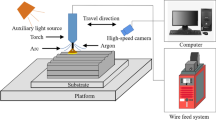Abstract
Twin-wire plasma arc additive manufacturing (TW-PAAM) is an innovative process for titanium aluminide manufacture which is low in equipment cost and high in efficiency. However, as an in situ alloying process, the composition homogeneity is typically a source of concern. The present work investigates this subject by observing the element input mode at various welding wire positions with a high-speed camera system and particle tracking method. It is found that when the welding wires are in a high position, the droplet enters the molten pool from the tip of the titanium wire, and the alloy element input interval is long, resulting in the formation of bands with high aluminium content at the edge of the deposition layer. When the welding wires are close to the workpiece surface, the droplet transfer mode switches to a mixture of dual wire-bridge transfer and Ti wire-bridge transfer. The diameter and transfer interval of the droplets decrease, as well as the heterogeneity of the deposition layer. The conclusion establishes a correlation between droplet transfer mode and composition homogeneity, which is beneficial for optimizing the TW-PAAM titanium aluminide fabrication process.











Similar content being viewed by others
References
Wu X (2006) Review of alloy and process development of TiAl alloys. Intermetallics 14(10):1114–1122. https://doi.org/10.1016/j.intermet.2005.10.019
Zhang X, Chen Y, Hu J (2018) Recent advances in the development of aerospace materials. Prog Aerosp Sci 97:22–34. https://doi.org/10.1016/j.paerosci.2018.01.001
Wu B, Pan Z, Ding D, Cuiuri D, Li H, Xu J, Norrish J (2018) A review of the wire arc additive manufacturing of metals: properties, defects and quality improvement. J Manuf Process 35:127–139. https://doi.org/10.1016/j.jmapro.2018.08.001
DebRoy T, Wei HL, Zuback JS, Mukherjee T, Elmer JW, Milewski JO, Beese AM, Wilson-Heid AD, De A, Zhang W (2018) Additive manufacturing of metallic components - Process, structure and properties. Prog Mater Sci 92:112–224. https://doi.org/10.1016/j.pmatsci.2017.10.001
Emiralioğlu A, Ünal R (2022) Additive manufacturing of gamma titanium aluminide alloys: a review. J Mater Sci 57:4441–4466. https://doi.org/10.1007/s10853-022-06896-4
Ma Y, Cuiuri D, Hoye N, Li H, Pan Z (2014) Effects of wire feed conditions on in situ alloying and additive layer manufacturing of titanium aluminides using gas tungsten arc welding. J Mater Res 29(17):2066–2071. https://doi.org/10.1557/jmr.2014.203
Ma Y, Cuiuri D, Hoye N, Li H, Pan Z (2015) The effect of location on the microstructure and mechanical properties of titanium aluminides produced by additive layer manufacturing using in-situ alloying and gas tungsten arc welding. Mater Sci Eng, A 631:230–240. https://doi.org/10.1016/j.msea.2015.02.051
Wang J, Pan Z, Cuiuri D, Li H (2019) Phase constituent control and correlated properties of titanium aluminide intermetallic alloys through dual-wire arc additive manufacturing. Mater Lett 242:111–114. https://doi.org/10.1016/j.matlet.2019.01.112
Wang L, Shen C, Zhang Y, Li F, Huang Y, Ding Y, Xin J, Zhou W, Hua X (2021) Effect of Al content on the microstructure and mechanical properties of gamma-TiAl alloy fabricated by twin-wire plasma arc additive manufacturing system. Mater Sci Eng A 826:142008. https://doi.org/10.1016/j.msea.2021.142008
Wang L, Zhang Y, Hua X, Shen C, Li F, Huang Y, Ding Y (2021) Fabrication of γ-TiAl intermetallic alloy using the twin-wire plasma arc additive manufacturing process: Microstructure evolution and mechanical properties. Mater Sci Eng A 812:141056. https://doi.org/10.1016/j.msea.2021.141056
Gadakh V, Badheka V, Mulay A (2021) Solid-state joining of aluminium to titanium: A review [J]. Proc Inst Mech Eng Part L 235(8):1757–1799. https://doi.org/10.1177/14644207211010839
Henckell P, Ali Y, Metz A, Bergmann JP, Reimann J (2019) In situ production of titanium aluminides during wire arc additive manufacturing with hot-wire assisted GMAW process. Metals 9(5):578. https://doi.org/10.3390/met9050578
Cai X, Dong B, Yin X, Lin S, Fan C, Yang C (2020) Wire arc additive manufacturing of titanium aluminide alloys using two-wire TOP-TIG welding: Processing, microstructures, and mechanical properties. Addit Manuf 35:101344. https://doi.org/10.1016/j.addma.2020.101344
Duan S, Guo H (2020) Determination of viscosity and surface tension of liquid Ni–Al–Ti system using the evaluated thermodynamic properties by AMCT. J Mater Sci 55(25):11071–11085. https://doi.org/10.1007/s10853-020-04841-x
Liu X, Lv X, Li C, Chen J, Bai C (2017) Surface tension of liquid Ti-Al alloys. Rare Metal Mater Eng 46(1):39–44. https://doi.org/10.1016/S1875-5372(17)30074-7
Zhang Q, Dong Q, Wang X, Wang Z, Sun D, Zhu M, Qian Y, Nagaumi H (2020) Predictions of solute mixing in a weld pool and macro-segregation formation during dissimilar-filler welding of aluminium alloys: Modelling and experiments. J Market Res 9(6):12080–12090. https://doi.org/10.1016/j.jmrt.2020.08.109
Shamsolhodaei A, Sun Q, Wang X, Panton B, Di H, Zhou Y (2020) Effect of laser positioning on the microstructure and properties of niti-copper dissimilar laser welds. J Mater Eng Perform 29(2):849–857. https://doi.org/10.1007/s11665-020-04637-9
Dong B, Pan Z, Shen C, Ma Y, Li H (2017) Fabrication of copper-rich cu-al alloy using the wire-arc additive manufacturing process. Metall and Mater Trans B 48(6):3143–3151. https://doi.org/10.1007/s11663-017-1071-0
Schwerdtfeger J, Körner C (2014) Selective electron beam melting of Ti–48Al–2Nb–2Cr: microstructure and aluminium loss. Intermetallics 49:29–35. https://doi.org/10.1016/j.intermet.2014.01.004
Gussone J, Hagedorn Y, Gherekhloo H, Kasperovich G, Merzouk T, Hausmann J (2015) Microstructure of γ-titanium aluminide processed by selective laser melting at elevated temperatures. Intermetallics 66:133–140. https://doi.org/10.1016/j.intermet.2015.07.005
Taguchi H, Haneda M, Imanaga S, Sejima I (1979) Metal transfer in plasma arc. J Jpn Weld Soc 48(7):488–493. https://doi.org/10.2207/qjjws1943.48.488
Ríos S, Colegrove P, Williams S (2019) Metal transfer modes in plasma wire + arc additive manufacture. J Mater Process Technol 264:45–54. https://doi.org/10.1016/j.jmatprotec.2018.08.043
Chen S, Zhang S, Huang N, Zhang P, Han J (2016) Droplet transfer in arcing-wire GTAW. J Manuf Process 23:149–156. https://doi.org/10.1016/j.jmapro.2016.05.014
Huang J, Li Z, Yu S, Yu X, Fan D (2021) Real-time observation and numerical simulation of the molten pool flow and mass transfer behavior during wire arc additive manufacturing. Weld World 66:481–494. https://doi.org/10.1007/s40194-021-01214-z
Xin J, Wu D, Shen C, Wang L, Hua X, Ma N, Tashiro S, Tanaka M (2022) Multi-physical modelling of alloy element transportation in wire arc additive manufacturing of a γ-TiAl alloy. Int J Therm Sci 179:107641. https://doi.org/10.1016/j.ijthermalsci.2022.107641
Funding
This research is supported by both the Science and Technology Commission of Shanghai Municipality (STCSM, Funding No. 19511106400, “Sailing Program” No. 19YF1422700) and the “JSPS International Research Fellow” project (21F31063).
Author information
Authors and Affiliations
Contributions
All authors contributed to the study conception and design. Material preparation, data collection, and analysis were performed by Xin Jianwen and Chen Haiyao. The first draft of the manuscript was written by Xin Jianwen and all authors commented on previous versions of the manuscript. All authors read and approved the final manuscript.
Corresponding author
Ethics declarations
Competing interests
The authors declare no competing interests.
Additional information
Publisher's note
Springer Nature remains neutral with regard to jurisdictional claims in published maps and institutional affiliations.
Rights and permissions
Springer Nature or its licensor (e.g. a society or other partner) holds exclusive rights to this article under a publishing agreement with the author(s) or other rightsholder(s); author self-archiving of the accepted manuscript version of this article is solely governed by the terms of such publishing agreement and applicable law.
About this article
Cite this article
Xin, J., Wu, D., Chen, H. et al. Effect of droplet transfer mode on composition homogeneity of twin-wire plasma arc additively manufactured titanium aluminide. Int J Adv Manuf Technol 124, 1723–1734 (2023). https://doi.org/10.1007/s00170-022-10592-7
Received:
Accepted:
Published:
Issue Date:
DOI: https://doi.org/10.1007/s00170-022-10592-7




